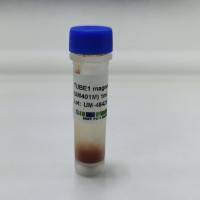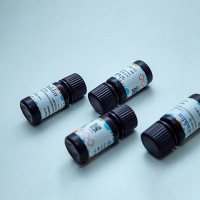In Vitro Opioid Receptor Assays
互联网
- Abstract
- Table of Contents
- Materials
- Figures
- Literature Cited
Abstract
Although opioid analgesics have been used for centuries, identification of opioid receptors and the ability of an opioid receptor antagonist to block natural pain processes prompted a search for endogenous opioid peptides. In vitro models were needed to characterize opioid activity in biological samples. The longitudinal muscle/myenteric plexus (LM/MP) of the guinea pig ileum was the classical in vitro assay system, but the development of the mouse vas deferens (MVD) assay provided another important model that could be employed. Both assays entail electrical stimulation of intramural nerves to produce muscle contractions of the target organ. The robust contractions of the LM/MP are inhibited by µ and ? opioid receptor agonists, while the more labile contractions of the MVD are inhibited by µ, ?, and ? opioid receptor agonists. These in vitro assay systems are useful for evaluating biological activity of unknown substances and studying the properties of drug tolerance and both are described in this unit. Curr. Protoc. Pharmacol. 55:4.8.1?4.8.34. © 2011 by John Wiley & Sons, Inc.
Keywords: opioid receptors; mu opioid receptors; kappa opioid receptors; delta opioid receptors; in vitro assays; mouse; guinea pig; longitudinal muscle/myenteric plexus; vas deferens
Table of Contents
- Introduction
- Basic Protocol 1: Evaluation of Opioid Activity in the Guinea Pig Ileum Longitudinal Muscle/Myenteric Plexus (LM/MP) Preparation
- Basic Protocol 2: Evaluation of Opioid Activity in the Mouse Vas Deferens (MVD) Preparation
- Support Protocol 1: Clean the System
- Support Protocol 2: Analyze the Data
- Reagents and Solutions
- Commentary
- Literature Cited
- Figures
- Tables
Materials
Basic Protocol 1: Evaluation of Opioid Activity in the Guinea Pig Ileum Longitudinal Muscle/Myenteric Plexus (LM/MP) Preparation
Materials
Basic Protocol 2: Evaluation of Opioid Activity in the Mouse Vas Deferens (MVD) Preparation
Materials
Support Protocol 1: Clean the System
Materials
|
Figures
-

Figure 4.8.1 Schematic representation of the guinea pig ileum. The various layers of the ileum are identified with the smooth muscle layers and their associated intramural nerve supplies. The myenteric plexus (Auerbach's plexus) provides sensory and motor innervation to the longitudinal muscle while the submucosal plexus (Meissner's plexus) provides similar innervation to the circular muscle. Both muscle‐nerve preparations possess opioid receptors with the longitudinal muscle/myenteric plexus preparation being the most common one employed in evaluating opioid activity in vitro. View Image -

Figure 4.8.2 Representation of the experimental setup. (A ). Schematic of the four‐tissue bath setup employed to hold the tissues. The circulating water bath is depicted to the right and the data acquisition system shown on the left. The temperature of the water baths should be monitored to make certain that they are 37°C for LM/MP and 30°C for the MVD. The output from the force transducer is led to the A/D converter shown on the far left hand side of the figure. (B ) Expanded view of the tissue bath arrangement illustrating the relationship of the tissue to the stimulating ring electrodes, the force transducer, and the carbogen inlet. Note that the force transducer is held by a clamp in an adjustable rack and pinion that is used to establish baseline tension. View Image -

Figure 4.8.3 Removal of the ileum. (A ) Schematic diagram of the opened guinea pig abdomen illustrating the relationship of the ileum to various organs. The ileum can be seen entering the cecum at the ileocecal plica, which provides an important landmark for excising the ileum to obtain the LM/MP preparation. (B ) Photograph of an excised ileum placed in Krebs‐Henseleit buffer. The ileum has been removed from its mesenteric attachment which removes the majority of the serous coat. The site of mesenteric attachment can be seen as a line running the length of the longitudinal muscle upon which most of the blood vessels converge. View Image -

Figure 4.8.4 Preparation of the LM/MP. (A ) Photograph of the ileum placed on the moistened pipet with bathing solution soaked cotton balls being used to remove the longitudinal muscle layer. Note the pipet in the holder and the use of one cotton ball to hold the tissue while the other is used to stroke the longitudinal muscle free from the underlying tissue. (B ) Photograph of the separated longitudinal muscle being removed from the remaining ileum. (C ) The separated longitudinal muscle in bathing solution prior to production of the final preparation for recording. (D ) The longitudinal muscle/myenteric plexus being prepared for the recording session with the two sutures attached to provide the base for holding the tissue and the connection to the force transducer. View Image -

Figure 4.8.5 The tissue holder/stimulating electrode combination. (A ) Photograph of the tissue holder/stimulating electrode illustrating the base for attaching the loop and the ring electrodes through which the tissue must be passed prior to connecting to the force transducer. The ring electrodes serve as the anode and cathode for electrical stimulation. (B ) Photograph of the tissue holder/stimulating electrode with a tissue attached at the base through the loop and extended through the ring electrodes. (C ) Photograph of the tissue holder/electrode combination placed in the tissue bath for connection the force transducer and stimulator. View Image -

Figure 4.8.6 Photograph of the stimulating arrangement that illustrates the Grass S48 stimulator connected directly to the Med‐Lab 4‐Channel Attenuator, which delivers the electrical impulse from the stimulator to the Med‐Lab Stimu‐Splitter II, which delivers the stimulus to the stimulating electrodes. This arrangement allows independent regulation of the output from the attenuator to each of four outputs in the Stimu‐splitter. It is possible to use a single voltage from the stimulator and provide individually regulated output to each one of four stimulating electrodes. View Image -

Figure 4.8.7 Representative tracing of a cumulative concentration‐response curve obtained from the data acquisition system. The effect of increasing concentrations of morphine on the amplitude of the neurogenic contractions of the guinea pig LM/MP is illustrated by the reduction in amplitude of the contractions. Note that the contractions reach a relatively constant level that is reduced in a concentration‐dependent manner. The exposure of the preparation to increasing concentrations causes a relatively rapid reduction in amplitude to a new steady level of contraction. Contractions were elicited at 10 sec intervals, so every 6 contractions equals 1 min. View Image -

Figure 4.8.8 Photographs of the mouse vas deferens (MVD) preparation. (A ) Photograph of the MVD as it is removed from the animal with the surrounding fat tissue still attached. (B ) Photograph of the “cleaned” preparation in which the fat tissue has been removed to expose the vas deferens, the epididymis and the testis. (C ) The separated vas deferens pinned to the Sylgard layer of a Petri dish prior to removal of the tissue sheath and the artery of the deferent duct. View Image -

Figure 4.8.9 Mean concentration‐response curves depicting the ability of morphine (A ) and DAMGO (B ) to inhibit the neurogenic contractions of LM/MP preparations obtained from naïve guinea pigs. The same tissues ( n = 10) were used to construct each concentration response curve which allows comparison of agonist activity. Curves were generated using GraphPad Prism. The calculated mean IC50 values are given in the inset and are consistent with expected IC50 values indicating that DAMGO is a more potent MOR agonist. View Image
Videos
Literature Cited
| Literature Cited | |
| Akil, H., Mayer, D.J., and Liebeskind, J.C. 1976. Antagonism of stimulation‐produced analgesia by naloxone, a narcotic antagonist. Science 191:961‐962. | |
| Akil, H., Watson, S.J., Young, E., Lewis, M.E., Khachaturian, H., and Walker, J.M. 1984. Endogenous opioids: Biology and function. Ann. Rev. Neurosci. 7:223‐255. | |
| Arunlakshana, O. and Schild, H.O. 1959. Some quantitative uses of drug antagonists. Brit. J. Pharmacol. 14:48‐58. | |
| Bertie, F., Bruno, F., Omini, C., and Racagni, G. 1978. Genotype dependent response of morphine and methionine‐enkephalin on the electrically induced contractions of the mouse vas deferens. Naunyn Schmiedebergs Arch. Pharmacol. 305:5‐8. | |
| Berzetei‐Gurske, I.P., White, A., Polgar, W., DeCosta, B.R., Pasternak, G.W., and Toll, L. 1995. The in vitro pharmacological characterization of naloxone benzoylhydrazone. Eur. J. Pharmacol. 277:257‐263. | |
| Calò, G., Rizzi, A., Bogoni, G., Neugebauer, V., Salvadori, S., Guerrine, R., Bianchi, C., and Regoli, D. 1996. The mouse vas deferens: A pharmacological preparation sensitive to nociceptin. Eur. J. Pharmacol. 311:R3‐R5. | |
| Cherubini, E. and North, R.A. 1985. Mu and kappa opioids inhibit transmitter release by different mechanisms. Proc. Natl. Acad. Sci. U.S.A. 82:1860‐1863. | |
| Corbett, A.D., Henderson, G., McKnight, A.T., and Paterson, S.J. 2006. 75 years of opioid research: The exciting but vain quest for the Holy Grail. Brit. J. Pharmacol. 147:S153‐S162. | |
| Donovan, J. and Brown, P. 1998. Anesthesia. Curr. Protoc. Immunol. 27:1.4.1‐1.4.5. | |
| Donovan, J.D. and Brown, P. 2006. Euthanasia. Curr. Protoc. Immunol. 73:1.8.1‐1.8.4. | |
| Fleming, W.W., Westfall, D.P., de la Lande, I.S., and Jellett, L.B. 1972. Log‐normal distribution of equieffective doses of norepinephrine and acetylcholine in several tissues. J. Pharmacol. Exp. Ther. 181:339‐345. | |
| Frigeni, V., Bruno, F., Carenzi, A., and Racagni, G. 1981. Difference in the development of tolerance to morphine and D‐Ala2‐Methionine‐enkephalin in C57 BL/6J and DBA/2J mice. Life Sci. 28:729‐736. | |
| Goldstein, A. and Schulz, R. 1973. Morphine‐tolerant longitudinal muscle strip from guinea‐pig ileum. Brit. J. Pharmacol. 48:655‐666. | |
| Goldstein, A., Lowney, L.I., and Pal, B.K. 1971. Stereospecific and nonspecific interactions of the morphine congener Levorphanol in subcellular fractions of mouse brain. Proc. Natl. Acad. Sci. U.S.A. 68:1742‐1747. | |
| Henderson, G. and Hughes, J. 1976. The effects of morphine on the release of noradrenaline from the mouse vas deferens. Brit. J. Pharmacol. 57:551‐557. | |
| Henderson, G., Hughes, J., and Kosterlitz, H.W. 1972. A new example of a morphine sensitive neuro‐effector junction: Adrenergic transmission in the mouse vas deferens. Brit. J. Pharmacol. 46:764‐766. | |
| Hughes, J., Kosterlitz, H.W., and Leslie, F.M. 1975. Effect of morphine on adrenergic transmission in the mouse vas deferens: Assessment of agonist and antagonist potencies of narcotic analgesics. Brit. J. Pharmacol. 53:371‐381. | |
| Johnson, S.M., Westfall, D.P., Howard, S.A., and Fleming, W.W. 1978. Sensitivities of the isolated ileal longitudinal smooth muscle‐myenteric plexus and hypogastric nerve‐vas deferens of the guinea‐pig after chronic morphine pellet implantation. J. Pharmacol. Exp. Ther. 204:54‐66. | |
| Knapp, R.J., Vaughn, L.K., and Yamamura, H.I. 1995. Selective ligands for µ and δ opioid receptors. In The Pharmacology of Opioid Peptides (L.F. Tseng, ed.) pp. 1‐28. Harwood Academic Publishers, Singapore. | |
| Kosterlitz, H.W. and Waterfield, A.A. 1975. In vitro models in the study of structure‐activity relationships of narcotic analgesics. Annu. Rev. Pharmacol. 15:29‐47. | |
| Johnson, S.M. and Fleming, W.W. 1989. Mechanisms of cellular adaptive sensitivity changes: Applications to opioid tolerance and dependence. Pharm. Rev. 41:435‐488. | |
| Leedham, J.A., Bennett, L.E., Taylor, D.A., and Fleming, W.W. 1991. Involvement of mu, delta and kappa receptors in morphine‐induced tolerance in the guinea pig myenteric plexus. J. Pharmacol. Exp. Ther. 259:295‐301. | |
| Lord, J.A.H., Waterfield, A.A., Hughes, J., and Kosterlitz, H.W. 1977. Endogenous opioid peptides: Multiple agonists and receptors. Nature 267:495‐499. | |
| Maldonado, R., Severini, C., Matthes, H.W.D., Kieffer, B.L., Melchiorri, P., and Negri, L. 2001. Activity of mu‐ and delta‐opioid agonists in vas deferens from mice deficient in MOR gene. Brit. J. Pharm. 132:1485‐1492. | |
| Martin, W.R. 1967. Opioid Antagonists. Pharm. Rev. 19:463‐521. | |
| Martin, W.R., Eades, C.G., Fraser, H.F., and Winkler, A. 1964. Use of hindlimb reflexes of the chronic spinal dog for comparing analgesics. J. Pharmacol. Exp. Ther. 144:8‐11. | |
| Martin, W.R., Eades, C.G., Thompson, J.A., Huppler, R.E., and Gilbert, P.E. 1976. The effects of morphine‐ and nalorphine‐like drugs in the nondependent and morphine‐dependent chronic spinal dog. J. Pharmacol. Exp. Ther. 197:517‐532. | |
| Miller, L. and Shaw, J.S. 1984. Mu‐receptors in the C57BL mouse vas deferens. Life Sci. 5:93‐96. | |
| Mosberg, H.I., Hurst, R., Hruby, V.J., Gee, K., Yamamura, H.I., Galligan, J.J., and Burks, T.F. 1983. Bis‐penicillamine enkephalins possess highly improved specificity toward δ opioid receptors. Proc. Natl. Acad. Sci. U.S.A. 80:5871‐5874. | |
| Paton, W.D.M. and Vizi, E.S. 1969. The inhibitory action of noradrenaline and adrenaline on acetylcholine output by guinea‐pig ileum longitudinal muscle strip. Brit. J. Pharmacol. 35:10‐29. | |
| Pert, C.B. and Snyder, S.H. 1973. Opiate receptor: Demonstration in nervous tissue. Science 179:1011‐1014. | |
| Portoghese, P.S. 1965. A new concept on the mode of interaction of narcotic analgesics with receptors. J. Med. Chem. 8:609‐616. | |
| Simon, E.J., Hiller, J.M., and Edelman, I. 1973. Stereospecific binding of the potent narcotic analgesic 3H‐etorphine to rat brain homogenate. Proc. Natl. Acad. Sci. U.S.A. 70:1947‐1949. | |
| Smith, J.A. and Leslie, F.M. 1993. Use of organ systems for opioid bioassay. In Handbook of Experimental Pharmacology, Vol. 104/I (A. Herz, H. Akil, and E. Simon, eds.) pp. 53‐78. Springer‐Verlag, Berlin. | |
| Surprenant, A. and North, R.A. 1985. µ‐Opioid receptors and α2‐adrenoceptors coexist on myenteric but not on submucous neurons. Neuroscience 16:425‐430. | |
| Taylor, D.A. and Fleming, W.W. 2001. Unifying perspectives of the mechanisms underlying the development of tolerance and physical dependence to opioids. J. Pharmacol. Exp. Ther. 297:11‐18. | |
| Terenius, L. 1973. Stereospecific interaction between narcotic analgesics and a synaptic plasma membrane fraction of rat brain cortex. Acta Pharmacol. Toxicol. 32:317‐320. | |
| Waterfield, A.A., Lord, J.A.H., Hughes, J., and Kosterlitz, H.W. 1978. Differences in the inhibitory effects of normorphine and opioid peptides on the responses of the vasa deferentia of two strains of mice. Eur. J. Pharmacol. 47:249‐250. |







